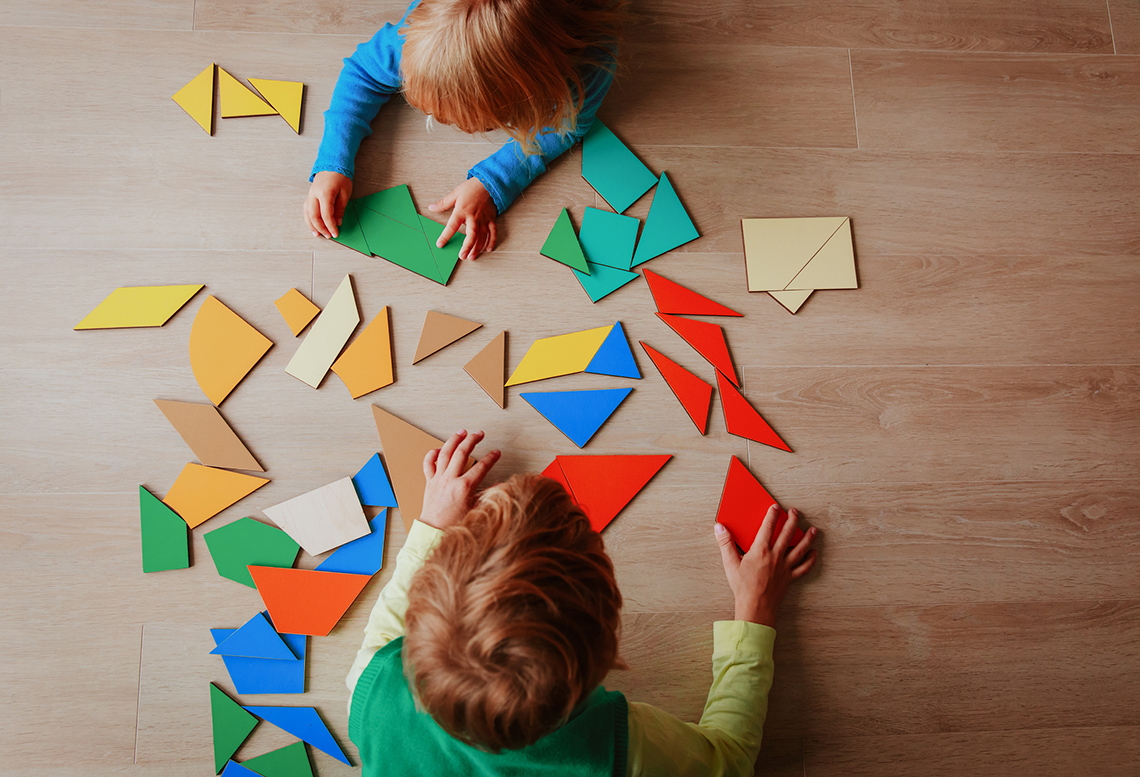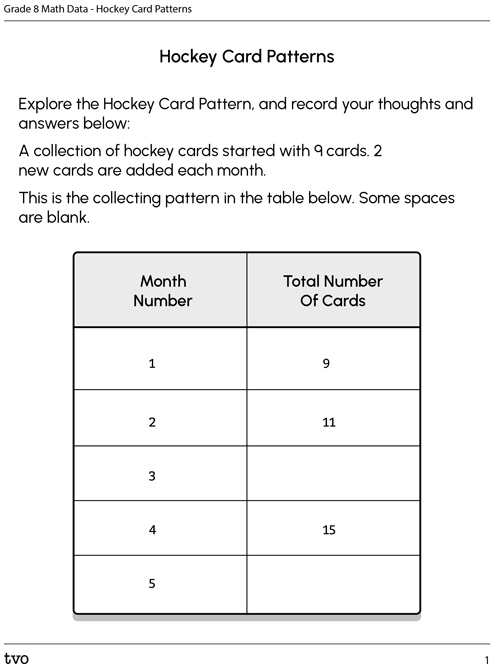Minds On
Pattern review
What kind of patterns are there?
Let’s do a quick review.
Press the different kinds of patterns to review your understanding of them.
For example: 5, 1, 9, 5, 1, 9…
5, 1, 9 is the core of this pattern. The core repeats.
For example: 1, 5, 9, 13, 17…
The pattern starts at 1 and increases by 4 each time. The numbers are getting bigger.
For example: 99, 96, 93, 90, 87…
The pattern starts at 99 and decreases by 3 each time. The numbers are getting smaller.
Extending patterns
Let’s extend the following patterns.
You may wish to use counters, blocks, or another method of your choice to help count and support your thinking!
Pattern 1
8, 18, 28, 8, 18, 28, (Blank), (Blank), (Blank)
- What kind of pattern is this?
- How do you know?
Record your ideas in your notebook or another method of your choice.
Pattern 2
Reflect on the following questions:
- What kind of pattern is this?
- How do you know?
- What would the next iteration or term be?
Record your ideas in your notebook or another method of your choice.
Action
Complete the patterns
Vegetable patterns
There is a pattern at a local vegetable stand.
People purchased some of the items.
- What pattern rule describes the pattern?
- Find the missing vegetables in the pattern.
- What kind of pattern is this? How do you know?
Record your ideas in your notebook or another method of your choice.
Press ‘Show Pattern’ to access the completed Vegetable Pattern.
This “Vegetable Pattern” is a repeating pattern with carrot, onion, broccoli, and pepper as the core. You can represent this pattern with letters, like A B C D.
You can also use the core to help figure out what’s missing, by repeating the pattern until all the spaces are filled in.
Check out the following completed vegetable pattern:
Hockey card patterns
A collection of hockey cards started with 9 cards. 2 new cards are added each month.
The collecting pattern is in the following table. Some spaces are blank.
| Month Number | Total Number Of Cards |
|
1 |
9 |
|
2 |
11 |
|
3 |
|
|
4 |
15 |
|
5 |
- What kind of pattern do you see?
- What pattern rule describes the card collecting pattern?
- Complete the table.
Complete the Hockey Card Patterns in your notebook or use the following fillable and printable document.
Press ‘Show Pattern’ to access the completed Hockey Card Pattern.
| Month Number | Total Number Of Cards |
|
1 |
9 |
|
2 |
11 |
|
3 |
13 |
|
4 |
15 |
|
5 |
17 |
In the third month of collecting cards, there are 13 cards, an increase of 2 from the month before. By the fifth month, there are 17 cards, 2 more than the month before.
This pattern is a growing pattern that starts at 9 and increases or adds by 2 each time.
Missing pattern blocks
Here is a design using pattern blocks. Someone accidentally jiggled the table and some of the pattern is missing.
There is a design made up of red trapezoids and blue triangles. There are six columns, left to right, labelled Term 1, Term 2, Term 3, Term 4, Term 5, and Term 6. The first column, Term 1, has a triangle at the top of the column with 12 trapezoids stacked beneath it. Term 2 has a triangle at the top of the column with 11 trapezoids stacked beneath it. There are no shapes in the Term 3 column, but there is a question mark. Term 4 has a triangle at the top of the column and 9 trapezoids stacked beneath it. There are no shapes in the Term 5 column, but there is a question mark. Term 6 has a triangle and 7 trapezoids stacked beneath it.
Explore the pattern above, and reflect on the following questions:
- What kind of pattern do you see?
- What pattern rule describes the pattern? How do you know?
- Complete the pattern.
Record your ideas in your notebook or another method of your choice.
Consolidation
Completing missing patterns

Complete and extend this pattern:
4, 11, 18, (Blank), 32, (Blank), (Blank) …
You may wish to use the hundred chart, counters, or another method of your choice to help count and support your thinking!
Record your answers in a notebook or a method of your choice.
Select the correct answer, then press “Check Answer” to see how you did.
For each sentence, select the missing phrase from the drop-down menu.
Create your own missing pattern
Follow the steps to create your own missing pattern:
- What type of pattern will it be? Repeating? Growing? Shrinking?
- Create your pattern and leave some missing parts in your patterns.
- Describe your pattern and show how someone else could determine the missing parts.
Complete the My Missing Pattern Activity in your notebook or use the following fillable and printable document. You can also use another method of your choice.
Reflection
How do you feel about what you have learned in this activity? Which of the next four sentences best matches how you are feeling about your learning? Press the button that is beside this sentence.
I feel...
Now, record your ideas about your feelings using a voice recorder, speech-to-text, or writing tool.

